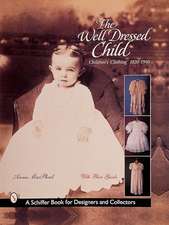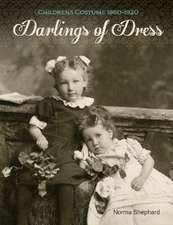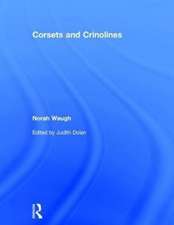Historical Perspectives on Sustainable Fashion: Inspiration for Change
Autor Dr Amy Twigger Holroyd, Jennifer Farley Gordon, Colleen Hillen Limba Engleză Paperback – 8 feb 2023
| Toate formatele și edițiile | Preț | Express |
|---|---|---|
| Paperback (1) | 171.36 lei 3-5 săpt. | +38.13 lei 7-13 zile |
| Bloomsbury Publishing – 8 feb 2023 | 171.36 lei 3-5 săpt. | +38.13 lei 7-13 zile |
| Hardback (1) | 466.81 lei 3-5 săpt. | |
| Bloomsbury Publishing – 8 feb 2023 | 466.81 lei 3-5 săpt. |
Preț: 171.36 lei
Preț vechi: 182.35 lei
-6% Nou
Puncte Express: 257
Preț estimativ în valută:
32.79€ • 34.23$ • 27.14£
32.79€ • 34.23$ • 27.14£
Carte disponibilă
Livrare economică 14-28 martie
Livrare express 28 februarie-06 martie pentru 48.12 lei
Preluare comenzi: 021 569.72.76
Specificații
ISBN-13: 9781350160439
ISBN-10: 1350160431
Pagini: 216
Ilustrații: 100 bw illus
Dimensiuni: 189 x 246 x 15 mm
Greutate: 0.62 kg
Ediția:2
Editura: Bloomsbury Publishing
Colecția Bloomsbury Visual Arts
Locul publicării:London, United Kingdom
ISBN-10: 1350160431
Pagini: 216
Ilustrații: 100 bw illus
Dimensiuni: 189 x 246 x 15 mm
Greutate: 0.62 kg
Ediția:2
Editura: Bloomsbury Publishing
Colecția Bloomsbury Visual Arts
Locul publicării:London, United Kingdom
Caracteristici
Updated with international examples and two new chapters on the fashion system and the role of the fashion consumer/user - this revised edition has been restructured to reflect the fashion production cycle from the cultivation of raw materials through manufacturing and distribution to reuse and recycling
Notă biografică
Amy Twigger Holroyd is Associate Professor of Fashion and Sustainability in the School of Art & Design at Nottingham Trent University, UK.Jennifer Farley Gordon is an affiliate faculty member in the Apparel, Events & Hospitality Management department at Iowa State University, USA. She is also an independent researcher, writer, and curator, and formerly worked as an assistant curator at The Museum at the Fashion Institute of Technology (MFIT) in New York, USA.Colleen Hill is Curator of Costume and Accessories at the Museum at FIT in New York, USA.
Cuprins
Introduction1. Materials and processesMaterials and processes: how did we get here?The development of cottonWool and its competitorsSilk and rayonSynthetic fibersUnconventional materialsThe invention of synthetic dyesHuman impacts of dyeingEnvironmental impacts of dyeingMaterials and processes: inspiration for changeOrganic cottonThe resurgence of woolHemp and flaxLyocell and bambooLower impact dyesNatural dyesMaterials and processes: thinking criticallyMaterials and processes: further reading2. Design and ManufactureDesign and manufacture: how did we get here?Clothing production before mechanizationAdvancements in spinning and weavingThe sewing machine and ready-made clothingChoice and disposabilityDesign and manufacture: inspiration for changeWartime restrictions and qualityPost-war coutureArtisanal techniques and slow fashion5Design featuresDesign and manufacture: thinking criticallyDesign and manufacture: further reading3. Reuse and RecyclingReuse and recycling: how did we get here?Repurposing practicesShawls and scrapsThe Great Depression and the Second World WarShoddy recyclingReuse and recycling: inspiration for changePost-war repurposingThe rise of vintageRepurposing and upcycling in the 1990s and 2000A new era of fiber recyclingReuse and recycling: thinking criticallyReuse and recycling: further reading4. Labor PracticesLabor practices: how did we get here?Textile millsChild laborGarment factoriesGlobalization and sweatshopsSubcontracting and safetyLabor practices: inspiration for changeUnionizationLabelingDesigner-led actionLabor rights in a globalized industryCooperatives and fair tradeLabor practices: thinking criticallyLabor practices: further reading5. Treatment of AnimalsTreatment of animals: how did we get here?Feather adornmentsThe use of furTrapping and farmingTreatment of animals: inspiration for changeAnti-feather campaignsAnti-fur campaignsFake and "ethical" furTreatment of animals: thinking criticallyTreatment of animals: further reading6. Fashion systemsFashion systems: how did we get here?Enclosure, capitalism and modernityThe European fashion system and the Industrial RevolutionConsumerism and changeFashion systems: inspiration for changeHow clothes are usedNew approaches to dressing the bodyChallenging social normsDomestic and custom makingLocal production and local distinctivenessRestricting and managing productionFashion systems: thinking criticallyFashion systems: further readingConclusionNotesSelect bibliographyGlossaryIndex
Recenzii
Succeeds in bringing together many of the themes and ideas around ethical fashion. (1st edition)
I have really valued this book since it was first published. It is well-written and accessible, but most importantly, through giving the historical perspectives, it shows the antecedents of the issues plaguing fashion now.
The book is aimed at fashion students - its layout, photographs and pitch make it a successful academic text. It is a springboard from which they are invited to delve deeper into the subject. (1st edition)
The ecological issues of the present day are pressing and we do not have all the answers. By looking to the lessons of history, fashion designers, manufacturers, consumers and resistors can each gain a deeper understanding of how we got to where we are today, and how we might use past practices as a departure point for radical change and as a sourcebook of inspirational methods to refresh present-day thinking. Through a clear structure, covering Materials and Process, Design and Manufacture, Reuse and Recycling, Labour Practices, and Treatment of Animals, the authors construct a usable past of origin stories and contemporary parallels in the production and consumption of clothing. The historical research sits alongside museum examples of surviving garments, while the contemporary debates engage with the latest arguments and the freshest responses to the urgent need to do fashion differently. By the close of the final chapter, which looks at fashion systems in the round, and encourages imaginative and speculative thinking, readers will be inspired to take up history's gauntlet and find new solutions to fashion's enduring problems. - Annebella Pollen, Professor of Visual and Material Culture, University of Brighton, UK
I have really valued this book since it was first published. It is well-written and accessible, but most importantly, through giving the historical perspectives, it shows the antecedents of the issues plaguing fashion now.
The book is aimed at fashion students - its layout, photographs and pitch make it a successful academic text. It is a springboard from which they are invited to delve deeper into the subject. (1st edition)
The ecological issues of the present day are pressing and we do not have all the answers. By looking to the lessons of history, fashion designers, manufacturers, consumers and resistors can each gain a deeper understanding of how we got to where we are today, and how we might use past practices as a departure point for radical change and as a sourcebook of inspirational methods to refresh present-day thinking. Through a clear structure, covering Materials and Process, Design and Manufacture, Reuse and Recycling, Labour Practices, and Treatment of Animals, the authors construct a usable past of origin stories and contemporary parallels in the production and consumption of clothing. The historical research sits alongside museum examples of surviving garments, while the contemporary debates engage with the latest arguments and the freshest responses to the urgent need to do fashion differently. By the close of the final chapter, which looks at fashion systems in the round, and encourages imaginative and speculative thinking, readers will be inspired to take up history's gauntlet and find new solutions to fashion's enduring problems. - Annebella Pollen, Professor of Visual and Material Culture, University of Brighton, UK


















